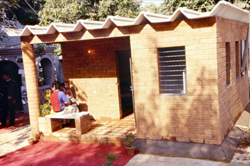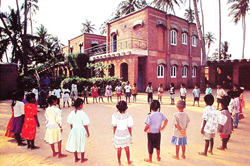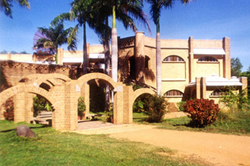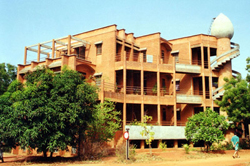 Sharanam - Phase II, Pondicherry built 2015 to 2018 |
 Kaza Eco-Community Centre, Kaza, Spiti Valley built 2013 to 2015 |
 Sri Vast Ashram Reception Hall, Bommiyarpalayam built 2014 to 2015 |
 AVEI Laboratory, Auroville built 2012 |
 Realization Community, Auroville built 2007 to 2012 |
 Jantanagar School, Jantanagar, Nepal built 2008 |
 Movable House, Auroville built 2008 |
 Model House, Simunye, South Africa built 2007 |
 Sri Karneswar Nataraja Temple, near Auroville built 2006 |
 Ermitage, Chinna Kalapet built 2006 |
 Community Training Centre, Marakkanam built 2005 to 2006 |
 Al Medy Mosque, Riyadh built 2004 |
 Volontariat Showroom, Pondicherry built 2004 |
 AVEI Training Centre, Auroville built 1989 to 2002 |
 The Aum House, Delhi, Orissa, Gujarat designed 1999 |
 Dhyanalinga Dome, Coimbatore built 1998 to 1999 |
 Minimum Emergency House, Istanbul built 1998 |
 Vikas Community, Auroville built 1991 to 1998 |
 Deepanam School, Auroville built 1994 to 1995 |
 Shakti Vihara School, Pondicherry built 1991 to 1994 |
 Kinshasa School, Kinshasa, Democratic Republic of Congo built 1990 |
 Auroville Visitors Centre built 1989 to 1992 |
Auroville Visitors' Centre Built 1989 to 1992 (40 months) |
Built for Auroville Foundation with funding from HUDCO, MNES, & UNCHS/Habitat at a cost of 30 lakh rupees |
Kinshasa School, Kinshasa, Democratic Republic of Congo Built 1990 |
UNIDO (United Nations for Industrial Development
Organisation) requested CRATerre-ENSAG in 1990 to
built a rural primary School on the outskirts of Kinshasa,
former Zaïre, as the first step of technology transfer with
this country. |
Shakti Vihara School, Pondicherry Built 1991 to 1994 (48 months) |
A school in Pondicherry for 700 children |
Deepanam School, formerly known at Mirramukhi School, Auroville Built 1994 to 1995 (20 months) |
Built for the Auroville Foundation with funding from the Government of India & the Auroville Foundation at a cost of 15 lakh rupees |
Vikas Community, Auroville Built 1991 to 1998 (45 months) |
Built for the collectivity of residents with funding from the residents, Auroville International centres, & the Auroville Foundation at a cost of 75 lakh rupees |
Minimum Emergency House (MINE House), Istanbul Built 1998 (2 weeks) |
Built for the UNCHS/Habitat through CRATerre with funding from UNCHS & the Government of Finland at a cost of 1000 USD |
Dome of the Dhyanalinga Temple for Lord Shiva, Coimbatore Built 1998 to 1999 (9 weeks) |
Built for the Isha Foundation at a cost of 11 lakh rupees |
The AUM House Built in 1 week with 2 weeks of training |
Designed as a low-cost, readily-built shelter for disaster-struck areas |
Auroville Earth Institute Training Centre, Auroville Built progressively 1989 to 2002 (approximately 60 months) |
Built for the Auroville Foundation & the Auroville Building Centre/Earth Unit with funding from HUDCO (India), KFW (Germany) & personal donations for a cost of 50 lakh rupees |
Al-Medy Mosque, Riyadh Built 2004 (7 weeks) |
Built for Ar-Riyadh Development Authority (Kingdom of Saudi Arabia) with funding from the City of Riyadh for a cost of 440,000 USD |
Volontariat Showroom, Pondicherry Built 2004 |
At the request of the NGO Volontariat, the Auroville
Earth Institute built a showroom in Pondicherry in collaboration
with a local contractor. |
Ermitage, Chinna Kalapet Built 2006 |
Built to be a retreat space for the fathers living in the Friary of St. John ashram
and guests visiting them. |
Community Training Centre, Marakkanam Built 2005 to 2006 |
Designed by Ar. Anjana Rai of the Earth Institute and built by the Earth Institute team at the request of the Intercultural Network for Development and Peace. |
Sri Karneswar Nataraja Temple, near Auroville Built 2006 (6 months) |
Built for Dr. Karan Singh, the chairman of the Auroville Foundation for a cost of 20 lakh rupees |
Model House, Simunye, South Africa Built 2007 |
The 30 m² model house was built in the community of Simunye, close to Johannesburg. This house served as a demonstration for the 4000 houses that were envisioned to follow in this rural community. |
Jantanagar School, Jantanagar, Nepal Built 2008 |
Satprem Maïni, director of the Auroville Earth Institute was invited to Nepal by the NGO Backward Society Education (BASE) to build a two classroom school in Jantanagar,
Bardiya district. The 97 m2 school is earthquake resistant, climate responsive and was built through significant community participation. |
Movable House, Auroville Built 2008 (8 days) |
Built as a low-cost and movable housing option for 2.1 lakh rupees in response to Auroville's growing population: |
Realization Community, Auroville Built 2005 to 2012 (56 months) |
Built for the collectivity of residents with funding from the residents and some outside donations for a cost of 2.17 crore rupees |
AVEI Laboratory & Dormitory Built 2012 |
The Earth Institute expanded its facilities in 2012 with this laboratory and dormitory building. The laboratory provided dedicated space for precise testing on materials and techniques, including soil properties, mechanical behavior of CSEB, Poured Earth concrete, waterproofing methods, thermal insulation, among others. The dormitory room can house two interns or staff members with superior comfort due to the natural ventilation and thermal insulation. |
Sri Vast Ashram Reception Building, Bommiyarpalayam Built 2014 to 2015 |
After initial concept sketches done by the Sri Vast Ashram team, the design of this three-room building was elaborated by the Earth Institute, with construction led by Earth Institute architects and masons. |
Kaza Eco-Community Centre, Spiti Valley, Himachal Pradesh Built 2013 to 2015 |
This community centre, funded by Spiti Projects and designed by the Earth Institute, is located in the Spiti Valley in the Himalayan state of Himachal Pradesh. With difficult road access, a barren landscape with limited natural resources, and extreme winter conditions, this building was constructed using the Valley's traditional earthen building techniques combined with passive heating systems and seismic reinforcement. |
Sharanam - Phase II, Pondicherry Built 2015 to current |
The Earth Institute has undertaken the design and construction of Phase II of the Sharanam Center for Rural Development in Pondicherry for the Sri Aurobindo Society. Phase II includes dormitory facilities as well as a conference hall seating 56. |
- Project Overview
- Sharanam Center for Rural Development, 2015-2018
- Kaza Eco-Community Centre, 2013-2015
- Realization Community, 2007-2012
- Movable House, 2008
- Nataraja Temple, 2006
- Marakkanam, 2005-2006
- Al Medy Mosque, 2004
- Aum House, 1999
- Dhyanalinga, 1998-1999
- Vikas Community, 1991-1998
- Deepanam School, 1994-1995
- Visitors Center, 1989-1992


